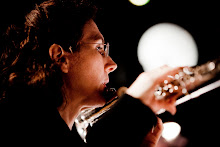Q: Should I notate the pitches as sounding or transpose up an octave?
A: Please transpose them up an octave. Flutists are not used to reading ledger lines below the staff.
Q: Can a bass flute play glissandi?
A: Yes. There are two things to be aware of though.
1) Most bass flutes don't have open holes like normal C flutes, so research with your local flutist if you want a smooth glissando over an interval larger than a minor second. From a middle C to E-flat, and the C to E-flat an octave above, the flutist can use the trill keys to effect a good glissando.
2) A long tube means the pitch is more difficult to manipulate. Unlike the piccolo, which can go out of tune if you look at it the wrong way, a bass flute requires more effort to bend the pitch. In the lowest octave, where the tube is the longest, a lip glissando of a quarter tone is about the easiest one can do. A lip glissando of a larger interval can be done if you allow the dynamics to help you. To let the dynamics help: use decrescendo for a downward slide, and a crescendo for an upward slide.
 | |
| A bass flute by Eva Kingma with open holes. Not every flutist is lucky enough to have one. |
The third octave of the bass flute is easiest for glissandi. Here you can use a combination of lips, adding or lifting keys to get a good glissando. For the exact range of a glissando on a particular note, it's best to check with the flutist for whom you are writing.
Q: Can a bass flute play microtones?
A: Yes. Third tones, quarter tones, and sixth tones are all possible. (Actually, the smaller intervals are easier, for me at least.) Since most bass flutes don't have open holes, there are basically two ways to produce microtones:
1) De-tune a normally fingered pitch by turning the flute in or out and adjusting with the lips. The lowest notes from its lowest C to E-flat (an octave below middle C) have to be done this way (see question above as to why that could be problematic).
2) Using a special fingering, usually a "shaded fingering" or "forked fingering" that adds keys to a normal fingering. These fingerings tend to sound very unstable and diffuse (it's a cool sound, but not always what you need).
Q: What about fast passages with microtones?
A: Beware of writing fast passages with microtones. On any flute, not just bass, learning a fast passage with non-standard fingerings will take the flutist not only twice as long, but I'd say up to ten times as long. That's fine if you are investing time in a solo work that will get a number of performances and you are sure every note will be heard and count for something.
Q: What about playing fast microtones with just the lip or turning the flute in or out?
A: That's fine if you have only quarter-sharps or only quarter-flats. Otherwise, you will have a good laugh watching a flutist bob his head in two directions at once. If you are lucky, the flutist will not bang his headjoint against his front teeth and claim liability.



Beautiful post, Helen. Thank you thank you.
ReplyDeleteBrava. Not just this post, but everything.
ReplyDeleteAdam Barr
adambarr1@gmail.com